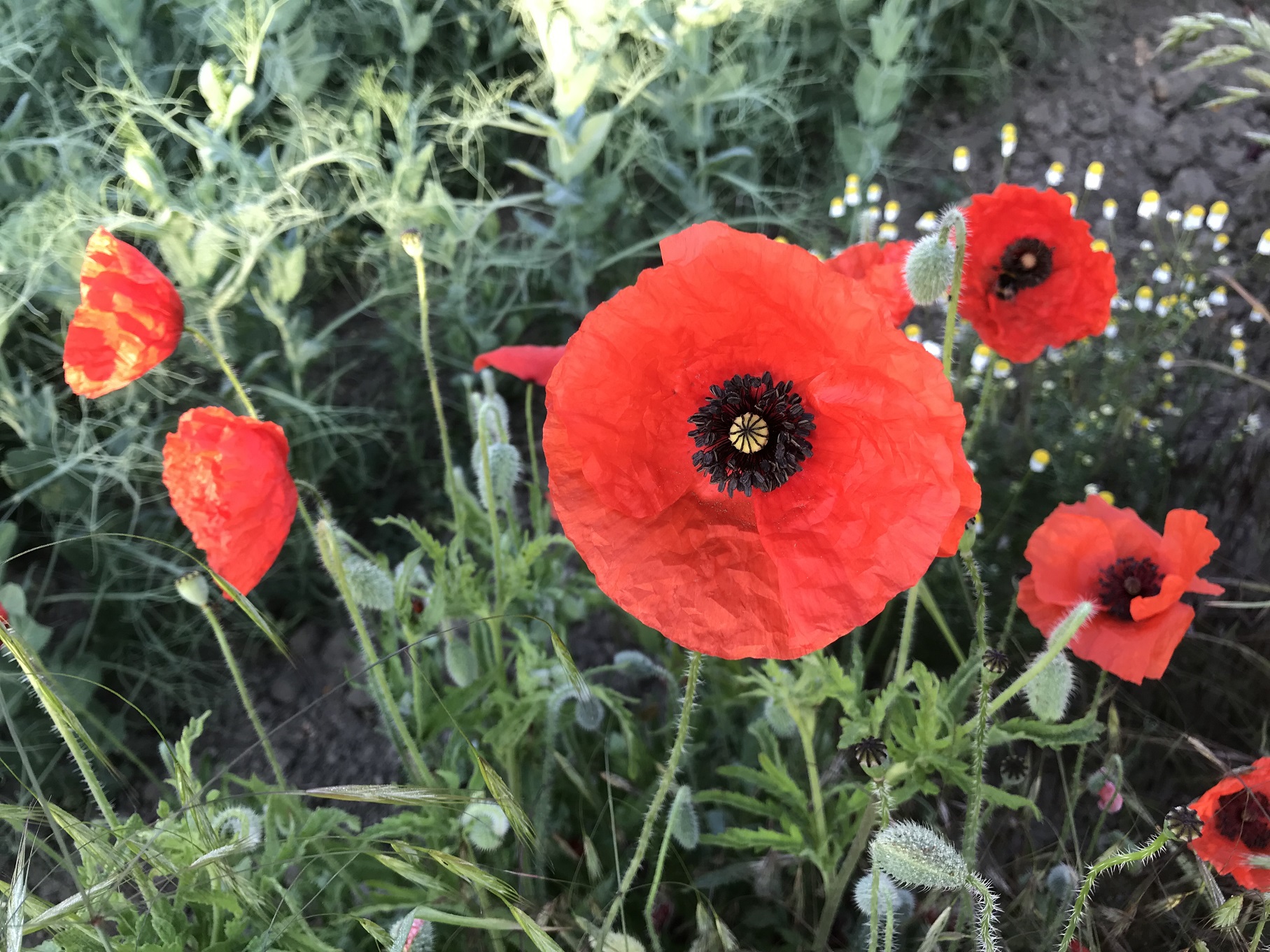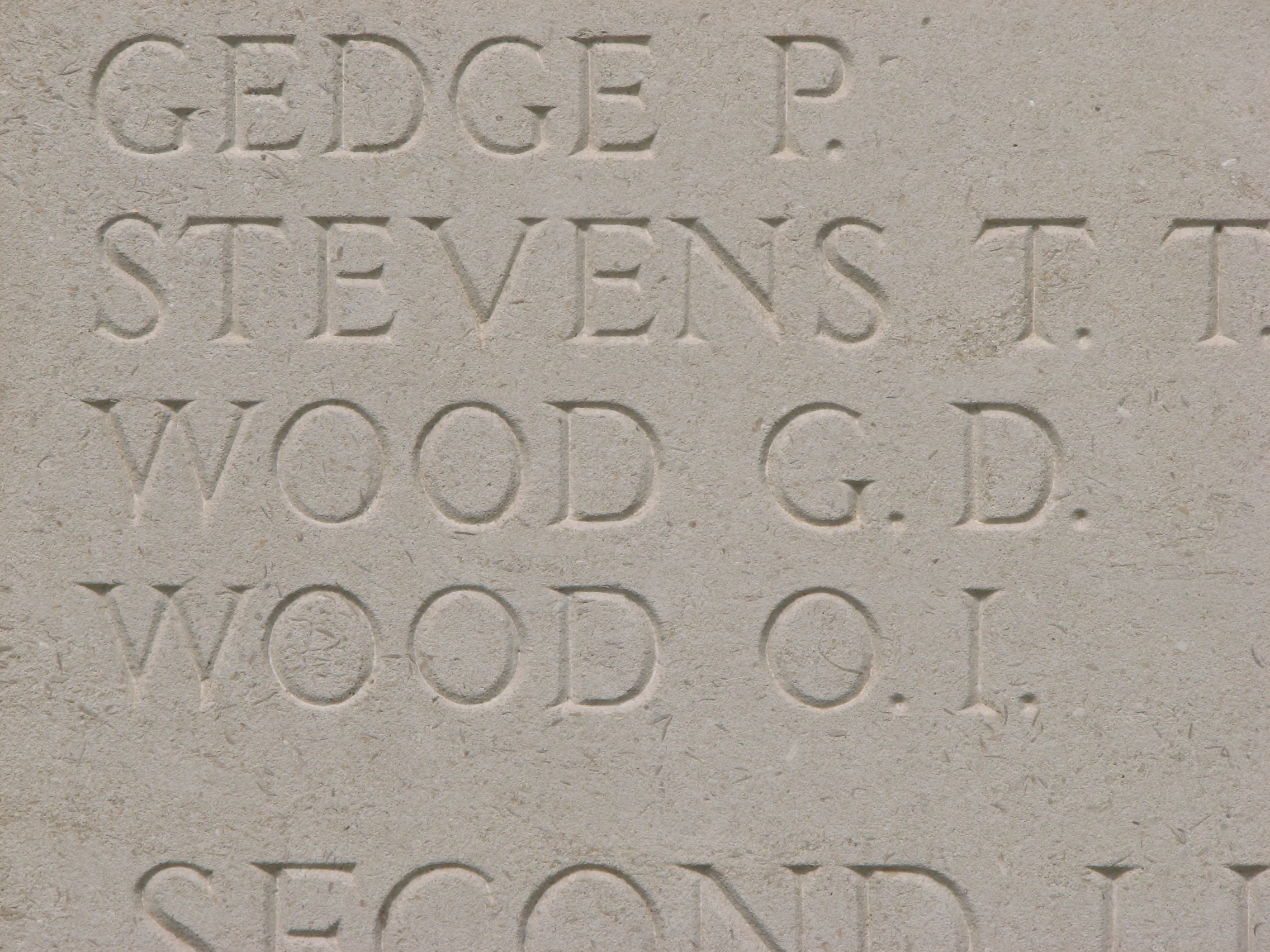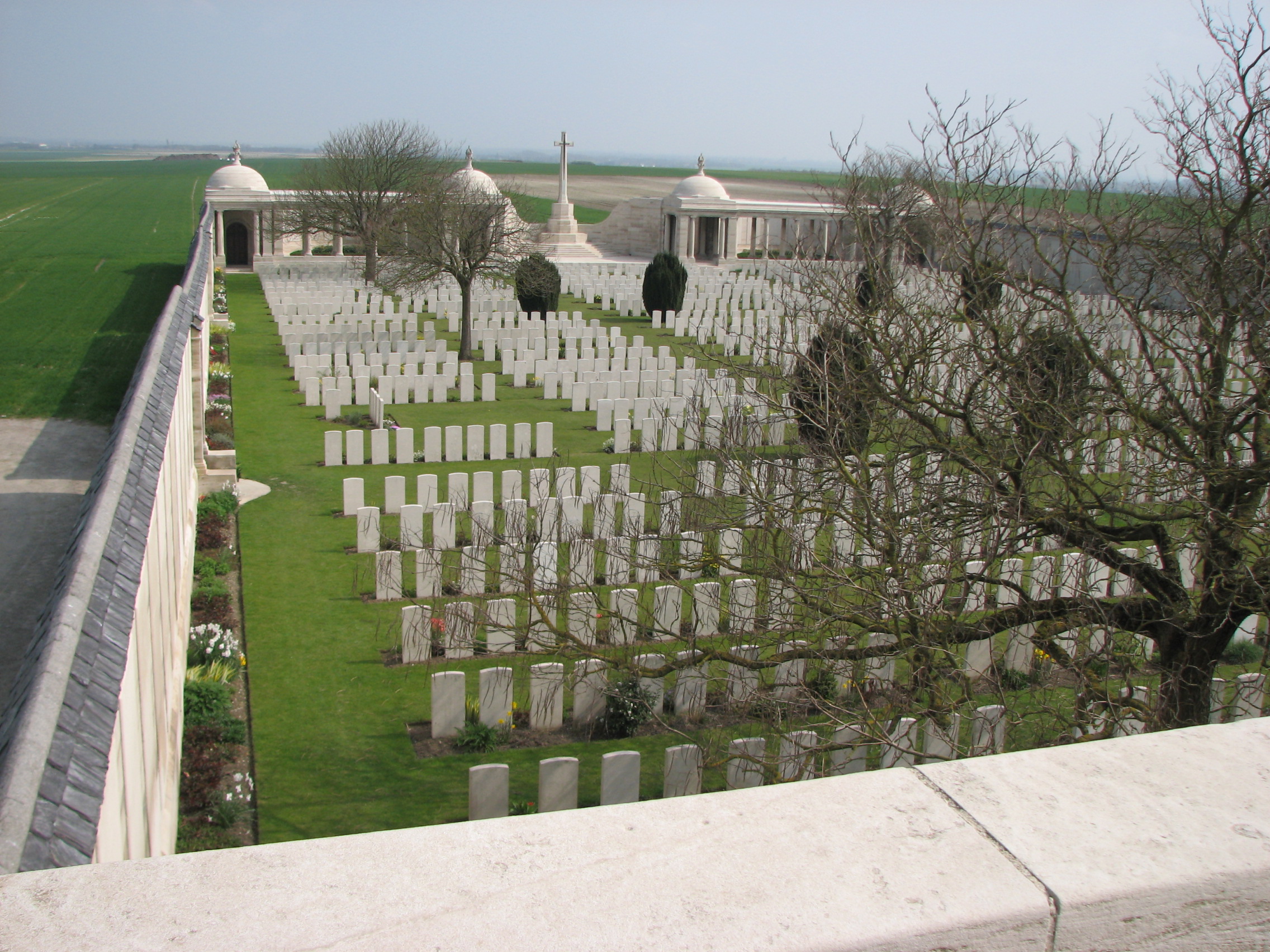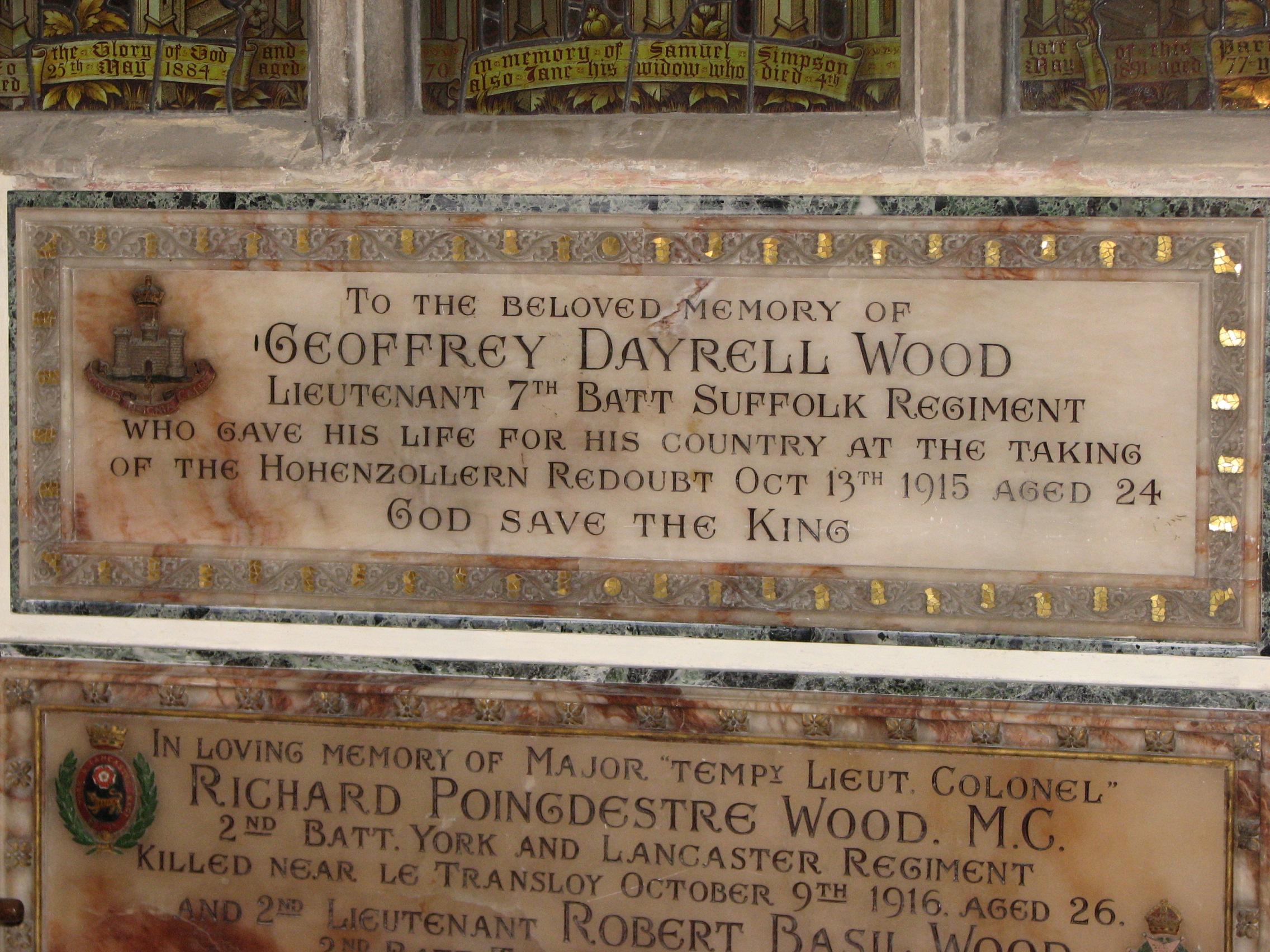Geoffrey Wood (1891 - 1915)
Brother of Richard Wood and Robert Wood. Geoffrey joined the Army in August 1914. He served with the 7th Battalion of the Suffolk Regiment on the Western Front, until his death during the Battle of Loos.
- 67
- Died in the Great War
- 51.970385, 1.017431
Details
| Name: | Geoffrey Dayrell Wood |
| Service: | British Army |
| Unit: | 7th Battalion, Suffolk Regiment |
| Rank: | Lieutenant |
| Date of Death: | 13th October 1915 |
| Age: | 24 |
| Commemorated: | Panel 37, Loos Memorial, near Lens, France |
Family Background and Early Life
Geoffrey Dayrell Wood was born at his parents’ house at 28 Greencroft Gardens, in Hampstead, London, on 19 August 1891. 1 Some sources state Geoffrey’s date of birth was 17th August 1891, however the entry in the Register of Births states that he was born on 19th August 1891.
Geoffrey’s father Ernest, was the third son of John and Francis Wood, of Melton Hall near Woodbridge, and a London Solicitor by profession. Ernest had married Katherine Grace Poingdestre from London in 1888. Geoffrey was the second of Ernest and Grace’s six children, all of whom were sons (though one died in infancy).
In addition to his elder brother Richard, and slightly younger brother, Robert, Geoffrey had a further two siblings: John (born in 1894), and Ernest (born in 1906).
As was the norm at that time, the sons of the upper and upper middle classes were educated away from home at boarding school. Geoffrey was no exception, and he went away initially to Eaton House in Aldeburgh, which was a Preparatory Boarding School.
At some point between 1901 and 1906, the Wood family left London, and moved to the White House on Rectory Hill in East Bergholt. 2 Ernest and Katherine renamed the property Melton Cottage. It has since reverted to its original name. Geoffrey and his brothers almost certainly spent a large part of their school holidays there.
At the age of 14 Geoffrey started as a pupil at Cheltenham College, one of the leading public schools in the country. He remained at Cheltenham College for 5 years, before going up to Exeter College at Oxford University in October 1910.
Sport
Throughout his academic studies, Geoffrey appears to have excelled at sport: Whilst at Cheltenham he played on the Cricket XI (which he captained in 1910), the Football XV and the Hockey XI. Later at Oxford, he played several times for the University Rugby Football Club and also excelled at Cricket. His achievements in that sport included, playing in the Freshmen’s cricket match of 1911, the Senior’s match the following year and one appearance in first class cricket for the University against the Marylebone Cricket Club. Geoffrey also played cricket for Suffolk in the Minor Counties Championship of 1910-11 and was a member of Lord’s.
Whilst he was at Oxford, Geoffrey had joined the Officer Training Corps (O.T.C.). The O.T.C. were intended to be similar to university clubs, though they were training units operated by the British Army. Their purpose was to provide some elementary military training and leadership skills, in order to provide potential officer candidates for the Army.
Joins the Army
Upon the outbreak of war with imperial Germany, Geoffrey applied for a commission in the Infantry, though he does not appear to have formally indicated a preference of Regiment. His Army Medical Report from this time records that the 22 year old Geoffrey was 5 foot 9 inches tall, and weighed 160 lbs. Perhaps unsurprisingly, Geoffery was also described as being fit.
Geoffrey’s commission as a 2nd Lieutenant in the Suffolk Regiment was awarded on 26th August 1914, and he was posted to their 7th Battalion. This was the first battalion of the Regiment that was raised specifically for the War, as a result of the large number of volunteers responding to Lord Kitchener’s call. 3 On 7th August 1914, Lord Kitchener, the Secretary of State for War and a national hero, issued his first appeal ‘an addition of 100,000 men’ to the Army. Within 2 months, nearly 750,000 men had enlisted.
The 7th was raised in Bury St. Edmunds in August 1914, and transferred shortly thereafter to Shorncliffe, near Folkestone in Kent. In February 1915, the Battalion was again transferred, this time to Aldershot. It was whilst they were stationed in Aldershot, that Geoffrey was promoted to the rank of Lieutenant.
France
The 7th Suffolks left Aldershot on 30th May 1915, and embarked on two ships at Folkestone that same evening. The crossings took approximately 90 minutes, and both ships had arrived at Boulogne in France by just after midnight.
The next month was spent in further training, including route marches, as well as providing working parties for the front line. The different companies of the Battalion were also sent on some short, 24 hour tours of duty in the trenches. It was during one of these that the Battalion suffered its first casualties.
The Battalion started to take over their portion of the front line near Ploegsteert Wood, south of the Belgian town of Ypres, on the morning of 4th July. This began an 11 week period alternating with the 9th Essex every six days. One Battalion would be in the front- line trenches, whilst the other battalion was in billets a mile or two in the rear, before they swapped places. Their time in billets was not a period of rest, as the Battalion were usually called upon to provide several hundred men for various Working Parties.
On 26th September the Battalion was formally relieved. They were being sent to the area just north of the French mining town of Lens, near a village called Loos-en-Gohelle.
The Battle of Loos
The Battle of Loos was part of a joint offensive with the French Army. It commenced on 25th September with some success, though the lack of reserves close to the front lines meant that the Germans were able to successfully counter attack and take back most of the gains.
The offensive was renewed on 13th October, with one of the objectives being the Quarries, near the village of Hulluch. This was to prevent them being used as a base from which the Germans could launch counter-attacks. This objective was allocated to two Brigades – one (which included the 7th Suffolks) was to attack from the West, whilst the other, would attack from the South.
The 7th Suffolks were to attack along two German communication trenches – collectively referred to as the Hairpin – which ran roughly parallel to one another from the British front line (which had previously been the German front line) to the German main front line at the edge of the Quarries. The Germans had built barriers – or stops – in the trenches, behind which they could mount a defence against an attack.
It was planned that A Company of the 7th Suffolks would attack along the left arm of the Hairpin, whilst D Company (including Geoffrey, and his men) would attack along the right arm. A third company – B Company – would attack over the top, across No Man’s Land under cover of a smoke screen.
In the early stages of the attack, D Company’s Commanding Officer was seriously wounded, and almost as soon as Captain Charles Sorley (the noted Poet) had taken over command of the Company, he was killed leading a charge against a barrier in the trench. Geoffrey – who was apparently helping his men to fill sandbags, in order to try to give the attackers some cover – was killed close by.
The Suffolks – though suffering heavy losses – eventually managed to clear the enemy from both trenches of the Hairpin, and consolidated their position on the edge of the Quarries
Postscript
One year after Geoffrey’s death, two of his brothers were killed. 4 Lieutenant Colonel Richard Poingdestre Wood, M.C., commanding the 2nd Battalion of the Yorkshire and Lancaster Regiment, was killed in action on 9th October 1916, during the Battle of the Somme, aged 26. Richard has no known grave, and is commemorated on the Thiepval Memorial to the Missing.
2nd Lieutenant Robert Basil Wood was killed in action on 12th October 1916 during a trench raid, near the village of Le Gheer, on the Franco-Belgian border. He was 23 years old. Robert is the only one of Ernest and Katherine’s sons that died in the Great War to have a known grave, and is buried in Tancrez Farm Cemetery, near Ploegsteert.
John Wood – or Jack as he was called – served as a Lieutenant in the Border Regiment. He was wounded, but survived the War. The Wood family are one of three East Bergholt families who each lost three sons in the Great War.
Ernest and Katherine erected two large tablets in memory to their sons, on the South Wall of the Chancel in St. Mary’s Church. They sold Melton Cottage in 1925 and moved away from East Bergholt though Katherine returned to the village following Ernest’s death in 1938. She then lived at Commandree on Gaston Street until her own death in 1944.
Geoffrey has no known grave and is now commemorated on the Loos Memorial to the Missing. The Memorial commemorates over 20,000 officers and men of the British Empire who fell in that area, and who have no known grave.
Copyright © Mark Ashmore, 2024
- 67
- Died in the Great War
- 51.970385, 1.017431




